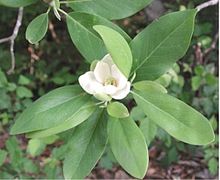| Magnoliaceae Temporal range:
| |
|---|---|

| |
| Magnolia virginiana | |

| |
| Liriodendron tulipifera | |
| Scientific classification | |
| Kingdom: | Plantae |
| Clade: | Tracheophytes |
| Clade: | Angiosperms |
| Clade: | Magnoliids |
| Order: | Magnoliales |
| Family: | Magnoliaceae Juss.[2] |
| Genera | |
| |
The Magnoliaceae (/mæɡˌnoʊliˈeɪsii/) are a flowering plant family, the magnolia family, in the order Magnoliales. It consists of two genera: Magnolia and Liriodendron (tulip trees).
Unlike most angiosperms, whose flower parts are in whorls (rings), the Magnoliaceae have their stamens and pistils in spirals on a conical receptacle.[3] This arrangement is found in some fossil plants and is believed to be a basal or early condition for angiosperms. The flowers also have parts not distinctly differentiated into sepals and petals, while angiosperms that evolved later tend to have distinctly differentiated sepals and petals. The poorly differentiated perianth parts that occupy both positions are known as tepals.
The family has about 219 species and ranges across subtropical eastern North America, Mexico and Central America, the West Indies, tropical South America, southern and eastern India, Sri Lanka, Indochina, Malesia, China, Japan, and Korea.
- ^ "Magnoliales". www.mobot.org. Retrieved 2023-06-18.
- ^ Angiosperm Phylogeny Group (2009). "An update of the Angiosperm Phylogeny Group classification for the orders and families of flowering plants: APG III". Botanical Journal of the Linnean Society. 161 (2): 105–121. doi:10.1111/j.1095-8339.2009.00996.x. hdl:10654/18083.
- ^ Zomlefer, Wndy B. (1994). Guide to Flowering Plant Families. The University of North Carolina Press. pp. 430. ISBN 978-0-8078-4470-0.